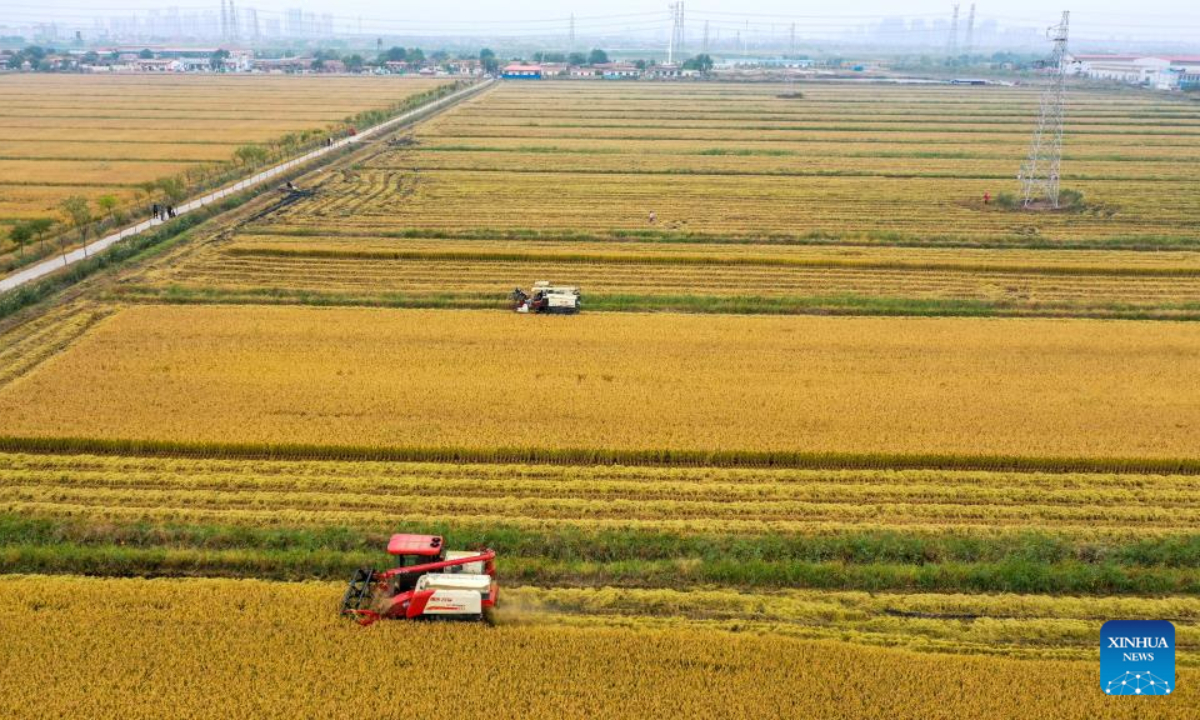
Aerial photo taken on Oct 13, 2022 shows a harvester working at a paddy field in Xiaozhan Town of Jinnan District in North China's Tianjin. Xiaozhan rice, which is a popular rice variety in China, is originated in Xiaozhan Town of Tianjin. Lately Xiaozhan rice has entered its harvest season. Photo:Xinhua
China's autumn harvest is in full swing with about 931 million
mu (62.1 million hectare) - more than 70 percent of all the farmland across China growing autumn plants - having been completed, as Chinese officials stressed food security during the ongoing 20th National Congress of the Communist Party of China (CPC).
This year's autumn harvest is 2.6 percentage points faster than the same period last year, CCTV reported on Sunday, citing latest data from the Ministry of Agriculture and Rural Affairs. Sunday, October 16, marked the World Food Day.
According to Cong Liang, head of the State Grain and Reserves Administration, China has a total of more than 1.9 billion
mu of farmland.
China's grain output has remained at above 650 million tons for seven consecutive years as the country had been improving its capability of ensuring food security over the past decade, with higher annual grain output and stable market operation, Cong told a press conference on the sidelines of the ongoing 20th CPC National Congress on Monday, the Xinhua News Agency reported.
With a sound food security situation, "China has guaranteed that its food supply remains firmly in its own hands," Cong was quoted as saying by Xinhua.
As for autumn harvest in specific regions, Northeast China had completed nearly 70 percent of this year's autumn harvest; the Yellow River-Huaihe River-Haihe River areas completed more than 75 percent; the northwest and southwest regions both completed more than 80 percent; and the middle and lower reaches of the Yangtze River and South China completed about 55 percent, according to CCTV.
In Suihua, Northeast China's Heilongjiang, a harvest of 15 million
mu of corn planted in local farmland is expected to be completed by the end of October with 65 percent completed so far.
In other parts of China, winter sowing has been carried out in an orderly manner. In Aksu Prefecture in Northwest China's Xinjiang region, 2.7 million
mu of winter wheat has already sprouted and farmers are busy preparing to protect the crop during the upcoming winter.
Modern machines and agricultural technologies have been playing a vital role in food production in China. Agricultural machines and technologies are now used in more than 61 percent of China's farmland, according to Cong.
In Xinjiang, the level of comprehensive mechanization of crop cultivating, sowing, and harvesting had reached 85.5 percent by the end of 2021. The total power of agricultural machinery increased from 19.7 million kilowatts to about 30 million kilowatts from 2012 to 2021, with an average annual increase of 4.8 percent, according to recent local media reports.
"Today, farming relies on machines and technology rather than physical labor. I have to work hard to learn more knowledge and skills to ensure a good harvest; this is the main trend," Feng Rugang, a farmer in Qitai county, Xinjiang, told media.
Thanks to the application of these advanced agricultural technologies and government assistance, Chinese experts predicted that the country would still see
a bumper harvest this year despite the unprecedented heat and drought in the south this summer.
More Chinese youth are also returning to the farmland and devote themselves to promoting the modernization of China's agricultural industry.
A 35-year-old farmer surnamed Lin from Ninghai county in East China's Zhejiang Province told the Global Times on Monday that he had spent about 200,000 yuan ($27,854) purchasing modern agricultural equipment such as drones and harvesters, and local authorities have provided subsidies for the purchases. "With the help of modern agricultural equipment, costs can be reduced by about 30 percent," Lin said.
Lin contracted about 400
mu (26.67 hectares) of farmland, and is scheduled to work on the autumn harvest from Tuesday and start winter wheat planting in November.




